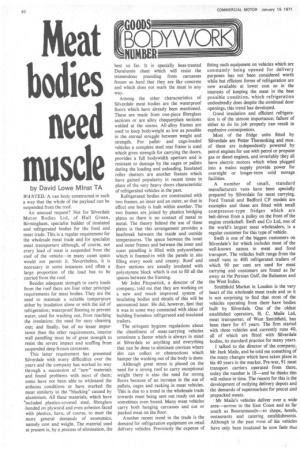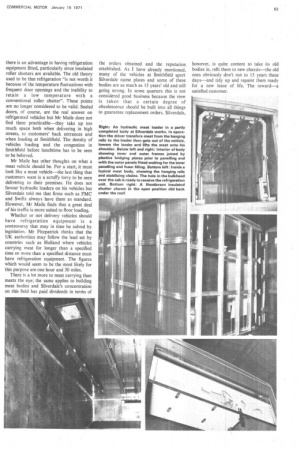62 Meat
Page 64

Page 65

If you've noticed an error in this article please click here to report it so we can fix it.
bodies need muscle
by David Lowe Mint TA
WA NTED: A van body constructed in such a way that the whole of the payload can be suspended from the roof.
An unusual request? Not for Silverdale Motor Bodies Ltd, of Hall Green, Birmingham, specialist builder of insulated and refrigerated bodies for the food and meat trade. This is a regular requirement for the wholesale meat trade and for specialist meat transporters although, of course, not every load of meat is suspended from the roof of the vehicle—in many cases space would not permit it. Nevertheless, it is necessary in some instances and often a large proportion of the load has to be carried from the roof.
Besides adequate strength to carry loads from the roof there are four other principal requirements for meat bodies. They are the need to maintain a suitable temperature either by insulation alone or with the aid of refrigeration; waterproof flooring to prevent water, used for washing out, from reaching the insulation; the need for easy cleaning out; and finally, but of no lesser importance than the other requirements, interior wall panelling must be of great strength to resist the severe impact and scuffing from suspended deep frozen carcasses.
This latter requirement has presented Silverdale with many difficulties over the years and the company has worked its way through a succession of "new" materials and found problems with most of them; some have not been able to withstand the arduous conditions or have marked the meat similarly to the "blacking" caused by aluminium. All these materials, which have 'included plastics-covered steel, fibreglass .bonded on plywood and even asbestos faced with plastics, have, of course, to meet the more general demands of economics, namely cost and weight. The material used at present is, by a process of elimination, the best so far. It is specially heat-treated Duralumin sheet which will resist the tremendous pounding from carcasses frozen so hard that they are like concrete and which does not mark the meat in any way.
Among the other characteristics of Silverdale meat bodies are the waterproof floors which have already been mentioned. These are made from one-piece fibreglass sections or are alloy chequerplate sections welded at the seams. All-alloy frames are used to keep bodyweight as low as possible in the eternal struggle between weight and . strength. For palletand cage-loaded vehicles a complete steel rear frame is used which gives strength for carrying the doors, provides a full bodywidth aperture and is resistant to damage by the cages or pallets during the loading and unloading. Insulated roller shutters are another feature which have gained popularity in recent times in place of the very heavy doors characteristic of refrigerated vehicles in the past.
Refrigerated bodies are constructed with two frames, an inner and an outer, so that in effect one body is built within another. The two frames are joined by plastics bridging plates so there is no contact of metal to metal. The theory behind the use of these plates is that this arrangement provides a heatbreak between the inside and outside temperatures. The space between the inner and outer frames and between the inner and outer panelling is filled with polyurethane which is foamed-in with the panels in situ filling every nook and cranny. Roof and floor sections are usually insulated with polystyrene block which is cut to fill all the spaces between the framing.
Mr John Fitzpatrick, a director of the company, told me that they are working on a new and much improved system of insulating bodies and details of this will be announced later. He did, however, hint that it was in some way connected with ideas of building frameless refrigerated and insulated trailers.
The stringent hygiene regulations about the cleanliness of meat-carrying vehicles constitute a factor which is always in mind at Silverdale so anything and everything that can be done to eliminate crevices where dirt can collect or obstructions which hamper the washing out of the body is done.
Although great stress is placed on the need for a strong roof to carry exceptional weight there is also the need for strong floors because of an increase in the use of pallets, cages and racking in meat vehicles. This is due to a trend in the wholesale trade towards meat being sent out ready cut and sometimes even boxed. Many meat vehicles carry both hanging carcasses and cut or packed meat on the floor.
Another recent trend in the trade is the demand for refrigeration equipment on retail delivery vehicles. Previously the expense of fitting such equipment on vehicles which are constantly being opened for delivery purposes has not been considered worth while but efficient forms of refrigeration are now available at lower cost so in the interests of keeping the meat in the best possible condition, which refrigeration undoubtedly does despite the continual door openings, this trend has developed.
Good insulation and efficient refrigeration is of the utmost importance; failure of either to do its job properly can result in expensive consequences.
Most of the fridge units fitted by Silverdale are Petter Thermoking and mos. of these are independently powered by petrol engines for use with petrol or propane gas or diesel engines, and invariably they all have electric motors which when plugged into a mains supply provide power for over night Or longer-term cold storage facilities.
A number of small, standard manufacturers vans have been specially prepared by Silverdale for meat carrying. Ford Transit and Bedford CF models are examples and these are fitted with small compressor-type fridges which are belt-driven from a pulley on the front of the engine crankshaft. Swift and Co Ltd, one of the world's largest meat wholesalers, is a regular customer for this type of vehicle.
Swift is one of the biggest customers on Silverdale's list which includes most of the well-known names in meat and food transport. The vehicles built range from the small vans to 40ft refrigerated trailers of which 90 per cent are used for meat carrying and customers are found as far away as the Persian Gulf, the Bahamas and the West Indies.
Smithfield Market in London is the very heart of the wholesale meat trade and so it is not surprising to find that most of the vehicles operating from there have bodies built by Silverdale. One of the oldest established operators, H. C. Maile Ltd, meat transporter, of West Smithfield, has been there for 47 years. The firm started with three vehicles and currently runs 40, all of which are fitted with Silverdale bodies, its standard practice for many years.
I talked to the director of the company, Mr Jack Maile, and he told me something of the many changes which have taken place in his 40 years in the market. Pre-war, 91 meat transport carriers operated from there, today the number is 18—and he thinks this will reduce in time. The reason for this is the development of outlying delivery depots and the demands of supermarkets for precut and prepacked meats.
• Mr Maile's vehicles deliver over a wide area—across to the East Coast and as far south as Bournemouth—to shops, hotels, restaurants and catering establishments. Although in the past most of his vehicles have only been insulated he now feels that there is an advantage in having refrigeration equipment fitted, particularly since insulated roller shutters are available. The old theory used to be that refrigeration "is not worth it because of the temperature fluctuations with frequent door openings and the inability to retain a low temperature with a conventional roller shutter". These points are no longer considered to be valid. Sealed doors, of course, are the real answer on refrigerated vehicles but Mr Maile does not find them practicable—they take up too much space both when delivering in high streets, to customers' back entrances and when loading at Smithfield. The density of vehicles loading and the congestion in Smithfield before lunchtime has to be seen to be believed.
Mr Made has other thoughts on what a meat vehicle should be. For a start, it must look like a meat vehicle—the last thing that customers want is a scruffy lorry to be seen delivering to their premises. He does not favour hydraulic loaders on his vehicles but Silverdale told me that firms such as FMC and Swifts always have them as standard. However, Mr Maile finds that a great deal of his traffic is more suited to floor loading.
Whether or not delivery vehicles should have refrigeration equipment is a controversy that may in time be solved by legislation. Mr Fitzpatrick thinks that the UK authorities may follow the lead set by countries such as Holland where vehicles carrying meat for longer than a specified time or more than a specified distance must have refrigeration equipment. The figures which would seem to be the most likely for this purpose are one hour and 30 miles.
There is a lot more to meat carrying than meets the eye; the same applies to building meat bodies and Silverdale's concentration on this field has paid dividends in tenths of the orders obtained and the reputation established. As I have already mentioned, many of the vehicles at Smithfield sport Silverdale name plates and some of these bodies are as much as 15 years' old and still going strong. In some quarters this is not considered good business because the view is taken that a certain degree of obsolescence should be built into all things to guarantee replacement orders. Silverdale, however, is quite content to take its old bodies in, refit them to new chassis—the old ones obviously don't run to 15 years these days—and tidy up and repaint them ready for a new lease of life. The reward—a satisfied customer.




































































































































